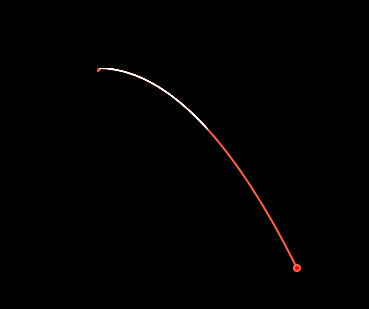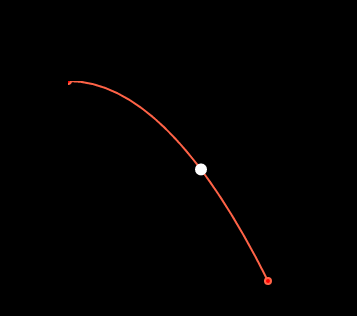canvas抛物线运动轨迹
本来是想做一个贝塞尔曲线运动轨迹的
公式太复杂了,懒得算,公式在最后

我先画了一个抛物线,我确定了两个点,起点(0,0),终点(200,200)
用坐标系可算出方程 y=-0.005x^2
现在找出终点的切线与X轴的交点,那个就是贝塞尔曲线的第二个参数,控制点
求出是(100,0)
现在重新绘制一个动态曲线,给X=X+0.1
y就是函数方程了y=0.005x^2 (注意没有负号了)
这样我们新绘制的线条就能在原来的红色线条上移动了
var oQuadraticCurveTo = document.getElementById("canvas");
var oContext = oQuadraticCurveTo.getContext("2d");
var x=2;
drawLine();
function drawLine(){
oContext.beginPath();
oContext.moveTo(0,0); //起始点(x,y)
oContext.quadraticCurveTo(100, 0, 200, 200); //创建二次贝塞尔曲线
oContext.lineWidth = 2;
oContext.strokeStyle = "tomato";
oContext.stroke();
oContext.closePath();
}
function drawPoint(x,y){
oContext.beginPath();
oContext.arc(x, y, 3, 0, 2 * Math.PI, false);
oContext.fillStyle="red";
oContext.fill();
oContext.stroke();
oContext.closePath();
}
//画移动的线
function drawMivie(){
y=Math.pow(x,2)*0.005
console.log(y);
oContext.beginPath();
oContext.moveTo(x,y);
x=x+0.1;
if(x > 198){
x=0;
}else{
//防止首位相连
y=Math.pow(x,2)*0.005
oContext.lineTo(x,y);
oContext.strokeStyle = "white";
oContext.lineWidth = 1;
oContext.stroke();
oContext.closePath();
}
}
drawPoint(0,0);
drawPoint(200,200);
//定位到起点
setInterval(function(){
drawMivie();
},1);
下面是一个改进版,小球沿着抛物线运动

var oQuadraticCurveTo = document.getElementById("canvas");
var oContext = oQuadraticCurveTo.getContext("2d");
var x=2;
function drawLine(){
oContext.beginPath();
oContext.moveTo(0,0); //起始点(x,y)
oContext.quadraticCurveTo(100, 0, 200, 200); //创建二次贝塞尔曲线
oContext.lineWidth = 2;
oContext.strokeStyle = "tomato";
oContext.stroke();
oContext.closePath();
}
function drawPoint(x,y){
oContext.beginPath();
oContext.arc(x, y, 3, 0, 2 * Math.PI, false);
oContext.fillStyle="red";
oContext.fill();
oContext.stroke();
oContext.closePath();
}
//画移动的线
function drawMivie(){
y=Math.pow(x,2)*0.005;
if(x > 198){
x=0;
}else{
//防止首位相连
//清楚之前的图,重新绘制
oContext.clearRect(0, 0, 500, 500);
oContext.closePath();
drawStatic(oContext);
//
x=x+1;
y=Math.pow(x,2)*0.005;
//画圆球
oContext.beginPath();
oContext.strokeStyle = "white";
oContext.arc(x,y,5,0,2*Math.PI,false);
oContext.fillStyle="white";
oContext.fill();
oContext.stroke();
oContext.closePath();
}
}
//画静态元素,红线和两端
function drawStatic(){
drawLine();
drawPoint(0,0);
drawPoint(200,200);
}
setInterval(function(){
drawMivie(oContext);
},20);
公式先丢出来,万一以后真的要做复杂的曲线呢。。
用下列一组数据点P(0,1) P(1,1) P(1,0) 作为特征多边形的顶点,构造一条贝齐尔曲线,写出它的方程并作图
n个数据点构成(n-1)次贝塞尔曲线,
三个数据点构成二次贝塞尔曲线,二次贝塞尔曲线参数方程
(1 - t)^2 P0
+ 2 t (1 - t) P1 + t^2 P2;
曲线起点P0,终点P2,但一般不过P1点.
代入坐标后得到:
参数方程:
x = (1 - t)^2 * 0 + 2 t (1 -
t) * 1 + t^2 * 1 = 2 t (1 - t) + t^2,
y=
(1 - t)^2 * 1 + 2 t (1 - t) * 1 + t^2 * 0 = (1 - t)^2 + 2 t (1 - t)
,
消去参数 t 得到:
y = -1 + 2
Sqrt[1 - x] + x.


 浙公网安备 33010602011771号
浙公网安备 33010602011771号